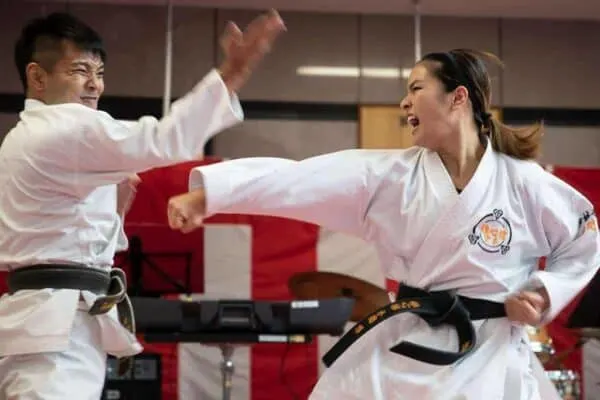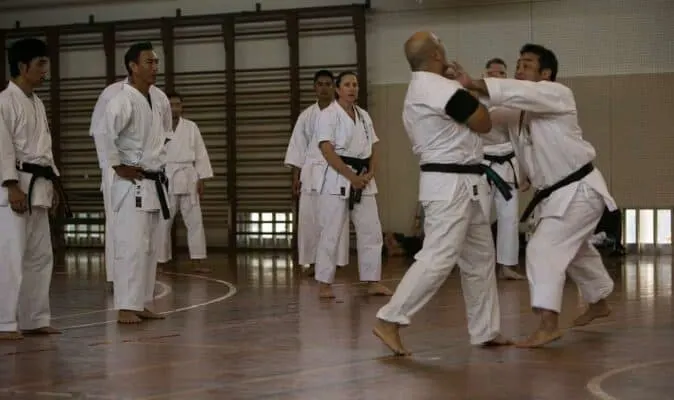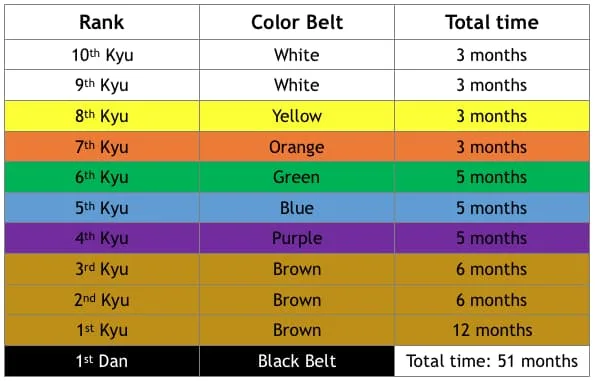
Karate is one of the most popular martial arts that is practiced by millions of people all around the world. Yet, despite being so popular, many people think that karate is not effective in real life, and that the techniques you learn won’t help you much on the streets. But where is the truth?
As a general rule, all karate falls into one of two different styles. The first is modern karate, and the second one is traditional karate(old school karate). The effectiveness of karate can be determined based on which style of karate it is.
Modern karate is ineffective in street fights because they are designed for sports competitions with rules and limits on where you can strike. In contrast, traditional karate is practical because it prepares you for real-life fighting where there are no rules and no limits.
Keep reading this article to learn more about the effectiveness of karate and different styles.
The History of Karate
Karate emerged in the Ryukyu Kingdom of Okinawa, Japan. Its story started when the people of the Ryukyu Islands got in touch with Chinese martial arts in the 14th century. This was also a time when King Sho Hashi banned all weapons on the island to protect his power. This decision forced the people to focus on developing hand-to-hand combat skills instead, which is how karate got started.
In its initial form, karate was designed to be very practical for real fighting. It was a brutal mix of striking with all limbs, grappling, fighting on the ground, and many other skills. The entire focus was on self-defense, and the following were the four initial styles:
- Goju-Ryu
- Shotokan
- Wado Ryu
- Shito-Ryu
The biggest change came in 1879 when Japan annexed the Okinawan islands. This triggered the migration of people, including skilled karatekas, to the main islands of Japan. Many of them started to open schools and travel across the country to teach karate, and this is also a time when the emphasis of karate began to change, and when many Japanese sports styles began to emerge.
RECOMMENDED READING: What Is The History of Kickboxing? – What You Need To Know
Three main karate categories
Karate has dozens of styles and forms which all fall into three main groups. This is crucial to know before going further into how practical each style is in real life. In fact, separating karate into these three groups gives you a good insight into which style is effective, which are not, and why.
- Okinawan karate
This is the initial style developed on the Okinawan islands back in the 14th century. A lot of people also refer to it as the “original karate” as it differs from the modern styles in many ways. In short, Okinawan is a brutal style that focuses entirely on self-defense and real combat. Each technique and method of training is designed to work in real life and inflict damage. Students learn how to strike with all limbs, fight on the ground, utilizes pressure point techniques, and even deal with basic weapons.
The entire concept revolves around you going into the fight to destroy the opponent in the most efficient way possible. Yes, there are a lot of katas (forms), but there is also a lot of hard sparring and randori. Some of the most popular Okinawan styles are:
- Goju-Ryu
- Uechi-Ryu
- Shorin-ryu
2. Japanese karate
Japanese karate emerged at the start of the 20th century. In 1879, Japan annexed the Okinawan islands, which triggered the migration of karatekas to the main islands. These karatekas started opening dojos all across the country with the idea to spread the art of karate. But, they needed to transform and adapt karate to the social context of Japanese people. Or in other words, to get rid of all the brutal techniques and change the emphasis to get legal acceptance. As such, techniques like elbows, knees, joint locks, pressure points and hard sparring were eliminated.
This is the reason why karate became less “brutal” and oriented more towards social education instead of self-defense. Once changed, it quickly became a part of the education program at schools and Universities. Although this allowed karate to grow, it certainly damaged its effectiveness when it comes to real fighting and the fighting abilities of its students. Some of the most popular Japanese styles are:
- Shotokan
- Wado-Ryu
- Shito-Ryu
3. Sports karate
Sports karate emerged from Japanese karate and, as its name suggests, focuses entirely on competition. It became so popular, notably after karate became a part of the Olympic Games, that the training methods in most modern-day dojos are oriented towards competition. The main goal is to prepare a person to compete under the point fighting rules where the focus is on speed, light contact, and precision. As a result, this form of karate is often seen as the least effective of them all.
Is karate effective in a street fight situation?
The effectiveness of karate in a street fight situation is mainly based on what style of karate one chooses to learn. Modern styles of karate are designed for sports competitions where you train to win karate tournaments. Traditional styles of karate, such as Okinawan karate as explained above, were designed for self-defense, where you have to defend yourself in real life.
That being said, regardless of the styles, the karate skills you develop are not as advanced as in some other similar arts, like boxing or Muay Thai. But at least all karate styles provide you with a basic understanding of the mental and physical aspects of real combat:
- how to stand in a proper stance
- use footwork to keep range and create angles
- strike using advanced kicks and basic punches
- block strikes and counterattacks

In most styles, the main emphasis of karate is on mixing kicks and punches with footwork and lateral movement. Each kick or punch that you learn is practical in real life.
What style of karate is the most effective for self-defense?
Karate has many styles and forms of which some are more effective than others when it comes to self-defense. Here is a list of some of the most effective ones:
Kyokushin karate
Kyokushin karate is often seen as one of the hardest martial arts because of its emphasis on brutal training methods. There is a lot of full-contact sparring where students blast each other with kicks and punches without wearing any protective gear. They do not wear any gloves, shin pads, or headgear. Though this may sound brutal, it adds to the realism of fighting you may encounter on the streets. Out on the streets, there are no rules or gear of any kind. So it is crucial for you to condition your body to absorb clean shots and learn how to strike back without hurting your hands.
One thing to note is that there are no punches to the head. Students are enabled to kick each other in the head and punch the body area below the neck.
Shidokan Karate
Founded in 1978 by Yoshiji Soeno, Shidokan karate falls into a group of modern styles. It differs a lot from most other styles because it includes techniques from other martial arts like:
- Kyokushin
- Judo
- Muay Thai
In short, Shidokan is one of the very few full-contact karate styles that visually looks very similar to kickboxing. In fact, even the training methods are similar as there is a lot of hard sparring. Apart from advanced striking skills, students also learn how to fight inside the clinch, and take the opponent down with powerful throws, sweeps, and trips from wrestling, BJJ, and judo.
Shotokan (traditional)
Shotokan karate is one of the most popular styles, if not the most popular. However, the effectiveness of this style truly depends on the dojo you train in. Some dojos embrace the traditional methods of teaching, while some are not. On paper, Shotokan is a versatile system that will prepare you for most scenarios you may face in real life. But in reality, most dojos put a lot of focus on forms, and sports variations of this style.
Traditional methods, on the other side, include a lot of self-defense training and are more practical in street fighting. Instead of learning how to win matches, or do workouts that won’t enhance your fighting abilities, you will learn proper stances, movement, and how to deliver strikes in the most efficient way possible.
RECOMMENDED READING: What are the Different Styles of Kickboxing? Simply Explained
Why do people say Karate is not effective?
Here is a list of reasons why a lot of people think that karate does not work in real life.
Effectiveness varies between styles and forms
In some way, people who say that karate is effective and the ones who say the opposite are both right. This is because the effectiveness of karate differs a lot between styles and forms. Some styles put more emphasis on real sparring, self-defense, and even damage, while the other ones focus on forms (katas) and light contact.
More about which karate styles are the most effective in the next segment of this article.
Focuses too much on competition
There is a clear difference between traditional and modern methods of teaching. Modern schools tend to focus more on competition and teaching you how to fight under strict rules. These “point fighting” rules are in contrast with what real fighting is all about as there is no fluid action.
The focus is on speed, high level of technique, precision, light contact and scoring points. The referee would reset the action after each point, which among many other things, clearly limits your abilities in a real fight. In some ways, the reflexes, habits, automatic reactions, and mindset that you develop in sports karate are dangerous in the application of a real fight.
The lack of full contact sparring
Most karate styles, apart from Kyokushin karate, do not include full-contact sparring. Instead, students are taught to overwhelm the opponent by utilizing speed, precision, and a high level of technique. According to karate philosophy, this allows them to beat the attacker without causing serious injuries, which in theory sounds nice.
But in reality, the lack of full-contact sparring has many cons and clearly limits your abilities in a fight. First, you won’t be conditioned enough to absorb full-blown shots, and your mind will probably go into panic mode when faced with a real-life fighting situation. And in most scenarios where your life is in danger, you have to be aggressive and cause damage to protect yourself.
RECOMMENDED READING: 10 Safest Martial Arts That Are Effective In Real Life
Is Karate effective in MMA?
Karate is more than present in modern MMA. Over the years, there have been many great fighters, including champions who have had a strong base in this traditional martial art. However, bear in mind that karate skills only won’t help you much inside the cage/ring. Certain elements of karate are only effective when combined with skills and techniques from other arts in MMA. Or in other words, each karateka who switches over to MMA has to learn how to wrestle, fight on the ground utilizing BJJ skills, and develop a strong Muay Thai game.
What top-level karatekas bring to the table is amazing footwork, lateral movement, and fast and precise striking. They all have an amazing ability to use footwork and long-range kicks to protect their distance. Once they decide to move in, they would attack in a blitz, and blast the opponent with high accuracy and from various angles. Fighters like Stephen Thompson are a tough matchup for anyone simply because it is hard to cut their movement, land a clean strike, and are very unpredictable.
Some of the most famous UFC fighters with a strong base in Karate are:
- Lyoto Machida — former LHW champion and a 3rd dan black belt in Shotokan
- Stephen Thompson — former title challenger and a karate black belt
- Robert Whittaker — former MDL champion and a black belt in Goju-Ryu.
How long does it take to learn karate?
On average, students need to spend around 3 to 5 years training hard and consistently to achieve the black belt rank. On one side, karate training is safe, playful, and most of the techniques students learn are direct and easy to learn. But on the other side, each style includes a belt ranking system and the promotional criteria are strict. Also, bear in mind that the difficulty and progression through the ranks vary between styles, dojos, and even countries. Here is a detailed table look into how long it takes to get each belt in karate (on average):

Is Karate hard to learn?
Most karate styles are not physically demanding and all of the techniques are direct and you won’t have a hard time picking up all the basics. Since most styles emphasize light contact, there is no hard sparring, which is a part of training that usually leads to minor or severe injuries. Even when students do live drills or spar, they all must wear shin pads, gloves, and headgear. This combined with light contact makes karate one of the safest, if not THE safest striking martial art.
But as with everything else in karate, the safety and intensity of the classes depend on the style. For example, Kyokushin is a rare exception as it is known in martial arts circles as the hardest karate style. In fact, it is often seen as the hardest martial art due to the lack of protective gear and its emphasis on sparring and hard methods of training.
RECOMMENDED READING: Which Martial Art Has The Most Injuries? FAQs
Final Thoughts – Is karate worth learning?
Overall, karate is worth learning because it meets the demands of just about every age group. On one side, there are hard styles for people who want to enhance their fighting abilities and learn self-defense tactics. And on the other, there are soft styles that are great martial arts for kids as their introduction into the world of martial arts, and maybe elderlies who want to stay active. These styles are soft but intense enough to provide you with a solid workout, and of course, a lot of fun.
Which karate style is the right for you really comes down to your personal preference and what you want to achieve with your training. But before you join the dojo, be sure to do deep research into all the styles, and find the one that fits you the best. Hope that this article has helped you to make the right decision.
